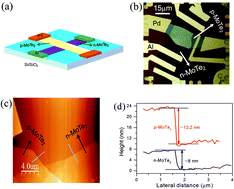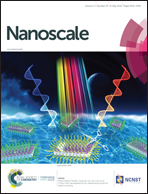MoTe2 van der Waals homojunction p–n diode with low resistance metal contacts†
Abstract
Although many studies have focused on transition metal dichalcogenide heterojunction p–n diodes, homojunction p–n diodes still require more extensive study. We present a van der Waals p-MoTe2/n-MoTe2 homojunction p–n diode with low resistance metal contacts. Such two-dimensional homojunction devices with low contact resistance can be used in various applications in the electronics industry. The device structure consists of stacked nanoflakes of p-MoTe2 and n-MoTe2. In this investigation, we implement a deep ultraviolet light-driven doping technique in a N2 gas environment to modulate the carrier concentration in a multilayered p-MoTe2 flake, which is consequently inverted to n-MoTe2. The deep ultraviolet light-driven doping provides environmental stability in the treated devices. We use ohmic metal contacts for the homojunction p–n diode and achieve excellent gate-dependent rectifying behavior with a rectification ratio of up to 104. Contrary to heterojunctions, the ideality factor is found to be 1.05 for the zero gate bias, indicative of good interface quality at the p-MoTe2/n-MoTe2 junction, owing to low charge trapping sites at the homojunction interface. In addition, low-temperature measurements are performed to determine the barrier height for different gate biases. This study contributes to research on van der Waals homojunction p–n diodes, which show much potential for nanoelectronic and optoelectronic devices.



 Please wait while we load your content...
Please wait while we load your content...